mobile View, to the German Version tap the flag


- parliamentary monarchy
- own name: Nihon Koku
• Flags
• Historical Flags
• Meaning/Origin of the Flag
• Coat of Arms
• Meaning/Origin of the Coat of Arms
• Aircraft Roundel
• Map
• Numbers and Facts
• History
• Origin of the Country's Name

National and merchant flag and naval jack,
ratio = 2:3,
Source, by: Flaggen und Wappen





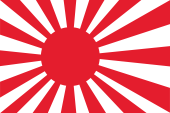
Naval and war flag,
ratio = 2:3,
Source, by: Flaggen und Wappen





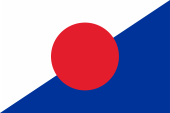
Customs flag,
ratio = 2:3,
Source, by: Das Flaggenbuch



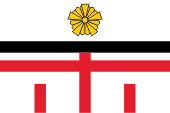
Flag of the Harbour Police,
ratio = 2:3,
Source, by: Das Flaggenbuch




Postal flag,
ratio = 5:7,
Source, by: By Zscout370 (Own work)
[CC BY-SA 3.0 or GFDL], via Wikimedia Commons



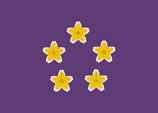
Flag of the Premier,
ratio = 5:7,
Source, by: Flags of the World



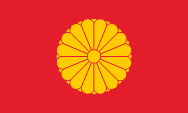
Flag of the Emperor,
ratio = 3:5,
Source, by: Flaggen und Wappen




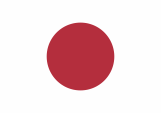
1870–1999,
National flag,
ratio = 7:10,
Source, by:
Wikipedia (EN)



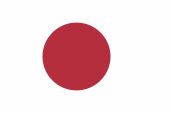
1870–1999,
Merchant flag und naval jack,
ratio = 2:3,
Source, by:
Wikipedia (EN)



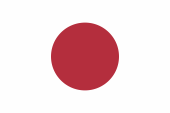
1999–2008,
National and merchant flag and naval jack,
ratio = 2:3,
Source, by:
Wikipedia (EN)



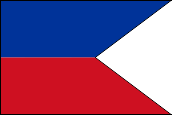
1945–1952,
Merchant and naval flag under Allied occupation,
ratio = 2:3,
Source, by:
Wikipedia (EN)




Japan’s flag, called the "Hinomaru" is white with a red sun disk in the centre, and was officially introduced on the 8th of August, 1854 for use at sea, and on the 27th of February, 1870 on land. Other Sources name as datum of the introduction of the flag the 5th of August in 1854, the 9th of July in 1854, and formal (official) Japanese Sources name even the year 1856. On 27th of February in 1870 a law was passed which allowed the use of the sun disk flag ashore and even its use as merchant flag in the navigation. For warships on that datum was introduced the naval flag and series of further special flags. This law also regulated the exact appearance of the national flag: proportions 7:10, the diameter of the red disc was set at 3/5 of the height of the flag. For the merchant flag it was further stipulated: Proportions 2:3 and the red disc is shifted one twentieth of the flag's length towards the mast. On 13th of August in 1999, the Law on the National Flag and the National Anthem was adopted, changing the proportions of the flag to 2:3. The shade of red was not precisely defined, only described as "deep". The colours have been defined in a Ministry of Defence document, first in 1973, red as "Munsell 5R 4/12" and white "Munsell N9". This would mean for the red that it would roughly correspond to: RGB 180|46|61, CMYK 6|95|67|25, Pantone 703. That document was amended on 21st of March in 2008, not least to comply with the requirements of the 1999 Act. Here the red is designated as "Munsell 5.7R 3.7 / 15.5" for printing on acrylic and as "Munsell 6.2R 4/15.2" for printing on nylon. As these colour specifications only serve the manufacturing process, but hardly clarify what constitutes a correct representation, the Japanese Development Agency (ODA), which reports to the Ministry of Foreign Affairs, has classified the red as "DIC 156". The DIC Corporation is a Japanese chemical company with its own colour standards. In this respect, the ODA interprets the colour red as CMYK 0|100|90|0, which would roughly correspond to: RGB 228|29|45, or Pantone 1788. Banners with sun or moon disks have a tradition going back about 1300 years in Japan. The red sun disk symbolizes the Japanese Emperors as direct descendant of the sun-goddess. White stands for honesty, sincerity and cleanliness, and red for courage, openness and passion.
Source:
Die Welt der Flaggen,
Flaggen Wappen Hymnen,
Flaggen und Coat of arms of the Welt,
Wikipedia (EN)

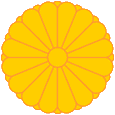
states's and emperor's coat of arms,
Source, by:
Corel Draw 4

The coat of arms of Japan is the imperial coat of arms. It shows a stylized, golden, 16-leaved chrysanthemum. This symbol is a so-called Mon, a Japanese family symbol, but the golden chrysanthemum may be used only by the imperial family. Is in this way also used on the standard of the emperor.
Source:
Die Welt der Flaggen,
Flaggen Wappen Hymnen


Flag of the Prefecture of Okinawa,
ratio = 2:3,
Source, by:
Wikipedia (EN)



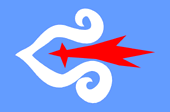
Flag of the native people on Hokkaido, the ”Ainu”,
Source, by:
Flags of the World





Aircraft Roundel,
Source, by: Wikipedia (EN)

Location:
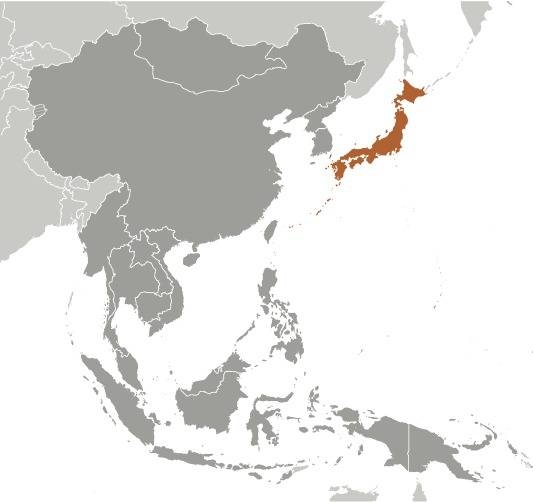
Source: CIA World Factbook
Map of the country:
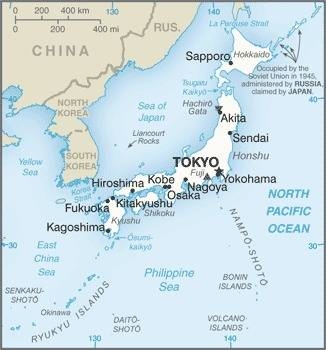
Source: CIA World Factbook

Area: 145.936 square miles
Inhabitants: 125.708.382 (2020), thereof 97.9 % Japanese, 0.6 % Chinese, 0.4 % Koreans, 1.1% Vietnamese, Filipino, Brazilian, and even 3.000 Germans
Religions: 69 % Shintoism, 66.7% Buddhism, 1.5 % Christian, 6.2 % other
Density of Population: 861 inh./sq.mi.
Capital: Tokio (to 1868 Yedo or Edo), 9.640.742 inh. (2021)
official Language: Japanese
other Languages: Korean, Chinese
Currency: 1 Yen (JPY, ¥) = 100 Sen
Time Zone: GMT + 9 h
Source:
Wikipedia (D),
CIA World Factbook,
Deutsche im Ausland

1st cent. B.C. · over 100 small states of various tribes in the today's Japan
2nd–3rd cent. · nascence of bigger tribe federations
645–702 · Taika reform, development of the empire
1192 · establishment of the Shogunate (military rule)
1637 · Japan isolates itself from the world
1853 · a military campaign of the USA forces Japan to open its ports and markets
1867 · elimination of the Shogunate, re-establishment of the Emperor's reign
1872 · modernization patterned after the West
1873 · purchase of the Bonin Islands and the Marcus Islands
1875 · purchase of the Kurile Islands
1876–1879 · conquest of the Ryukyu Islands (Okinawa)
1889 · new constitution following the style of the German Empire
1894–1895 · Chinese-Japanese war, victory of Japan, purchase of Formosa (Taiwan) and the Pescadores Islands, China has to grant Korea independence
29th of April 1901 · birth of the later emperor Hirohito
1904–1905 · Russian-Japanese war, victory of Japan, purchase of South Sakhalin and the Liaotung peninsula (Port Arthur), establishment of Korea as a Japanese protectorate
1910 · Japan annexes Korea
1914–1918 · Japan participates in the First World War on the side of the allies
1919 · the dictate of Versailles assigns to Japan the administration of German colonies in the Pacific (Marshall-, Caroline- and Mariana-Islands) and Japan receives the German colony of Kiaochow
1921 · Hirohito becomes regent (in substitution of his diseased father Taisho)
1926 · death of Taisho, his son Hirohito becomes the new emperor
1927 · start of the era of radical nationalism, in the Pacific conflicts of interests with the USA
1931 · military intervention of Japan in Manchuria, establishment of the Japanese satellite state of Manchoukuo
1937 · military intervention of Japan in China
1938 · phasing of public live in Japan, rule of the military
1939 · Japanese-Soviet frontier war, Japan suffers a defeat
1940 · Japan occupies French Indochina
1941 · total trade embargo of the USA against Japan, a cause for a foreseeable collapse of the Japanese economy
7th of December 1941 · Japan answers with an attack on the US-american naval base Pearl Harbor and starts with the occupation of US-american, British and Dutch possessions in the Pacific
4th–7th of June 1942 · sea battle of Midway, defeat of Japan, gradual back push of the Japanese troops
6th and 9th of August in 1945 · the USA drop atomic bombs on Hiroshima and Nagasaki and kill 150 000 civilians
2nd of September 1945 · capitulation of Japan, Japan loses its possessions, the Ryukyu Islands, and the Bonin and Marcus Islands are occupied by the USA
1945–1947 · US military government
1947 · new constitution, following the style of the US-american constitution, ousting of the emperor from the rule
1952 · peace treaty of San Francisco, Japan gets back its right of self-determination
1968 · Japan gets back the Bonin and Marcus Islands
1972 · Japan gets back the Ryukyu Islands (Okinawa)
1989 · death of Emperor Hirohito
1997 · start of a severe economic crisis, gradual economic recovery in the following years
Source:
Atlas zur Geschichte,
Discovery '97,
Weltgeschichte,
Wikipedia (D)

The worldwide common name for the country, "Japan", comes from sources outside of Japan. He probably goes back to the Malay word "Jepang" for the today's country of Japan. Portuguese sailors brought this country name to Europe in the 16th century, from where it has found worldwide commonness. The Japanese themselves call their country "Nihon", a word composed of the syllables "ni" and "hon", which are to translate with "day / sun" and "origin / beginning". Japan is therefore known as the "Land of the Rising Sun". The name "Nihon" was chosen in 6th/7th century to clarify in letters to the Chinese emperors, where the country of the sender is placed. The name "Nippon" (synonymous with Nihon) is more official and is used on stamps and banknotes or in international traffic. Originally the country was called "Wakoku", a name that goes back to the Chinese neighbors and means "land of the short people".
Source:
Wikipedia (D),
Stanisław Meyer

Kindly supported by: Rainer Bertram
partial Translator of the English text: Joachim Nuthack

![]()














































